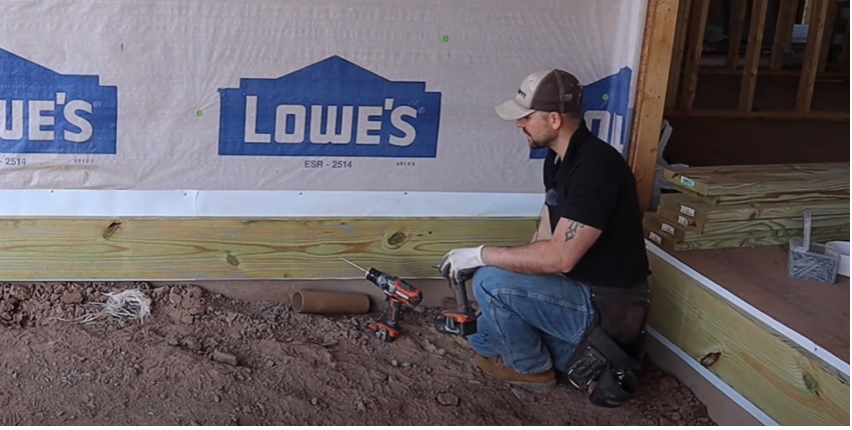This is the second part in a series of articles where I explain how to build a deck in phases (to read the first part, click here). In this phase, you’ll learn how to install a ledger board, cut posts, and attach a beam where the front of your deck will be.
As always, before you start any DIY homebuilding project, CHECK YOUR LOCAL BUILDING CODES.
Tools and Materials Needed To Install a Ledger Board, Posts, and Beam
DISCLAIMER – This article does contain affiliate links. I earn a small commission that helps support this website at no extra cost to you, if one of the links is used to make a purchase.
To properly install the ledger board, posts, and beam for your deck, you’ll need to gather up quite a few tools and materials. Most of them you should already have lying around, but there are a couple of items that are specific to decking.
Let’s get into them!
- Vinyl flashing
- 16’ and 8’ 2×10 pressure treated boards
- Hammer drill
- Impact driver
- Hammer
- 1 ¼” siding or roofing nails
- 3 ½” Tapcon concrete screws
- 3” 12-penny galvanized nails
- 4” lag bolts
- Circular saw
- Sawzall
- Speed square
- Pencil
- Tape measure
- String line
- Level
Side Note: If you want to know what brands of tools I use for my DIY deck builds, take a look at the Excellent Laborer Amazon store.)
Step by Step Guide To Building a Deck: Ledger Boards, Posts, and Beam
Step 1: Install vinyl flashing on all the exterior house walls that surround the deck area.
To do this, unroll the flashing and line up the bottom of it with the bottom of the sill plate on your exterior wall.

Tack it into place using aluminum roofing or siding nails. Ensure that it stays even as you unroll it.

Side Note: Always use vinyl flashing instead of aluminum flashing. When aluminum is pressed up against pressure treated wood, like the 2x10s you’re about to install as the ledger boards, it initiates a chemical reaction that completely rots out the flashing.
Without flashing, there won’t be a seal between the ledger board and the house to prevent moisture from seeping in and damaging the foundation. That’s why vinyl is the better material in this application.
Step 2: Use your pencil to make a mark underneath the doorway to the porch at the point where you want the top of the ledger board to rest.

In my live demonstration of this tutorial, I made a mark 1” beneath the doorway. This is because I know what material I want to use for my decking, and I know that it’s 1” deep. Furthermore, I want the transition between the floor inside the house and the deck of the porch to be completely level.
You can always adjust your marks if your decking is thicker or thinner than 1”. You can also make a step leading down onto the deck, if you’d prefer that instead of it being level with the floor inside the house.
Step 3: Tack 2x10s into place on top of the flashing using 3” 12-penny galvanized nails, all the way around the deck area.
To do this by yourself, use blocks of wood to prop the boards up while you’re securing them with nails. Be sure to use your level to check that all the boards are straight and even.


If any of the boards sit against a masonry wall, use a hammer drill to drill holes in the boards and an impact driver to secure them with 3 ½” Tapcon concrete screws.

Step 4: Lay out where the joist hangers for the decking will be on the ledger board, so that you know where to install lag bolts.
A joist hanger is a metal piece that serves as the attachment point between the ledger board and a floor joist.
To figure out the joist hanger layout, take a piece of your decking and prop it up on top of the ledger board. Line up the center of the deck board with the break between two ledger boards. Then, make a mark on the ledger board at each end of the deck board.


Next, measure the distance between the points you marked. Using that measurement, mark an evenly spaced layout on the ledger board all around the deck area.
Step 5: Install the lag bolts with washers in between the joist hanger marks.
To do that, drill a hole using your hammer drill and a ¾” bit along the ledger board in a wide W pattern, about every 2’. Then, use your impact driver with a ⅜” bit to screw in the 4” lag bolts with washers.



At the end of each individual 2×10 board, install two lag bolts for extra security. That means at the break between two 2x10s, you’ll need to install a total of four lag bolts.

Step 6: Cut out notches in your posts for the beam to rest on.
To do this, start by extending a string line across the edge of your deck area from one end of the ledger board on one side of the house to the end of the band board on the other side of the house. The string line should rest on top of the posts. The line where it rests will be the back of the notch you need to cut out of each post. Mark it with your pencil.


Next, use your pencil and speed square to mark the notches on each of your posts.

The beam I constructed in my live demonstration consists of two 2x10s, so I made the notch in each post 9 ¼” tall and 3” deep. (The real height of 2×10 boards is 9 ¼”, not 10”. Similarly, the depth is 1 ½”, not 2”.)
Use your circular saw and Sawzall to cut out the notches you marked.


Step 7: Secure the posts back in the ground.

Step 8: Assemble the beam.
To assemble the beam, rest a layer of 2×10 boards on the notches you cut out in your posts. Then, secure them to the posts and the ends of the ledger boards on either side of the deck area. Use a combination of 8’ and 16’ 2x10s, so that the joint between boards always breaks on one of the posts.

Use your level to check that this first layer is level. If it isn’t, hammer it into place.

Next, install a second layer of 2×10 boards next to the first layer and nail them into place. Stagger the joints with a combination of 8’ and 16’ 2x10s.


Check that your beam is straight by hooking a string line 1 ½” out from the walls on either side of the deck area. To do this, nail a small 2×4 on the exterior of each wall and hook either end of the string line on the nail.

Then, use your tape measure to check that the gap between the beam and the string line is roughly 1 ½” all along its length.

Step 9: Finish securing the two layers of 2x10s that make up the beam by nailing them together with decking screws. Spread the nails in a wide W pattern on the inside of the beam, and in neat vertical rows on the beam’s outside face.

And you’re done!

Be sure to check back here and on the Excellent Laborer YouTube channel for the next tutorial for how to build a deck, the DIY way!
